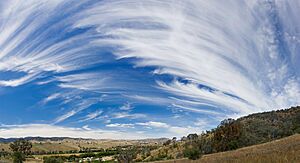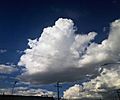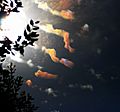Cloud facts for kids
A cloud is made of tiny water droplets or ice crystals. These float in the sky above the ground. They form visible shapes and formations.
Water on Earth evaporates. This means it turns into an invisible gas. This gas then rises high into the sky. Higher up, the air gets much colder. The water gas then condenses. It changes back into tiny drops of water or ice crystals. We see these tiny drops as clouds. Later, these drops fall back to Earth as rain. Then the water evaporates again. This whole process is called the "water cycle".
The air around us always has some water vapor. Clouds form when the air cannot hold any more invisible water vapor. Any extra water vapor then turns into tiny water drops.
Contents
How Clouds Form
Warm air can hold more water vapor than cool air. So, if warm air with lots of water inside cools down, it can form a cloud. Here are some ways air cools enough to make clouds:
- Air near the ground gets heated by the sun. It rises to where the air is colder.
- Along weather fronts, warmer air meets colder air and cools down.
- When air goes up the side of a mountain, it cools as it goes higher.
- Warm air cools when it moves over something colder. This could be cool water in a lake or ground that cooled overnight.
Clouds are actually very heavy. The water in a cloud can weigh millions of tons! But each cubic meter of a cloud has only about 5 grams of water. Cloud droplets are also much heavier than air. They stay up because warm air surrounds them. When water turns from gas to droplets, it releases heat. This heat helps the tiny droplets "stick" to the warm air.
Sometimes, clouds look very colorful at sunrise or sunset. This happens because of tiny dust particles in the air.
Cloud Types and Classification
Clouds are grouped by how they look. They are also grouped by how high they are in the sky. This system was first suggested in 1803. Clouds look different because the air where they form can be still. Or it can be moving up, down, or forward at different speeds. Very thick clouds with large water droplets can bring rain or snow. The biggest clouds can even cause thunder and lightning.
There are five main families of clouds based on their appearance:
- Cirrus clouds are high and thin. The air is very cold up high. So, these clouds are made of ice crystals, not water droplets. Cirrus clouds are sometimes called mares' tails. This is because they look like a horse's tail.
- Stratus clouds look like flat sheets. They can be low (stratus), medium (altostratus), or high (cirrostratus). Thick ones that bring rain or snow are called nimbostratus.
- Stratocumulus clouds look like rolls or ripples. They can be low (stratocumulus), medium (altocumulus), or high (cirrocumulus).
- Cumulus clouds are puffy and small when they first form. They can grow into bigger heap clouds. These are sometimes called towering cumulus.
- Cumulonimbus clouds are very large cumulus-type clouds. They often have cirrus tops. They have their own unique look.
Here is a summary of the main cloud types. They are arranged by how high they form:
High-Level Clouds
High clouds form very high up. They are found from 10,000 to 25,000 feet in cold places. In mild regions, they are from 16,500 to 40,000 feet. In very hot tropics, they can be from 20,000 to 60,000 feet high. They are too high and thin to make rain or snow.
High-level clouds include:
- Cirrus (Ci)
- Cirrocumulus (Cc)
- Cirrostratus (Cs)
Medium-Level Clouds
Middle clouds usually form around 6,500 feet in colder areas. But they can form as high as 25,000 feet in the tropics. Middle clouds are usually made of water droplets. They can also have some ice crystals. They sometimes produce rain or snow. This usually evaporates before it reaches the ground.
Medium-level clouds include:
- Altocumulus (Ac)
- Altostratus (As)
Low-Level Clouds
Low-level clouds are usually seen from near the ground. They can be as high as 6,500 feet. Low clouds are usually made of water droplets. They may sometimes produce very light rain, drizzle, or snow.
Low-level clouds include:
- Stratocumulus (Sc)
- Stratus (St)
When a very low stratus cloud touches the ground, it is called fog.
Moderate-Vertical Clouds

These clouds are medium in thickness. They can form anywhere from near the ground to 10,000 feet high. The tops of these clouds are usually not much higher than 20,000 feet. Vertical clouds often create rain and snow. They are mostly made of water droplets. But they can also have ice crystals when they push up into colder, higher levels.
Moderate-vertical clouds include:
- Cumulus (Cu)
- Nimbostratus (Ns)
Towering-Vertical Clouds
These clouds are very tall. Their tops are usually higher than 20,000 feet. They can create heavy rain and snow showers. Cumulonimbus clouds are the biggest of all. They can also produce thunderstorms. These clouds are mostly made of water droplets. But the tops of very large cumulonimbus clouds are often made mostly of ice crystals.
Towering-vertical clouds include:
- Towering cumulus (Tcu)
- Cumulonimbus (Cb)
Images for kids
-
Stratocumulus stratiformis perlucidus over Galapagos, Tortuga Bay (see also 'species and varieties')
-
Isolated cumulonimbus cloud over the Mojave Desert, releasing a heavy shower
-
Altocumulus lenticularis forming over mountains in Wyoming with lower layer of cumulus mediocris and higher layer of cirrus spissatus
-
Cirrus fibratus radiatus over ESO's La Silla Observatory
-
Cumulus partly spreading into stratocumulus cumulogenitus over the port of Piraeus in Greece
-
Global cloud cover, averaged over the month of October 2009. NASA composite satellite image.
-
Joshua Passing the River Jordan with the Ark of the Covenant (1800) by Benjamin West, showing Yahweh leading the Israelites through the desert in the form of a pillar of cloud, as described in Exodus 13:21–22
-
Stratocumulus stratiformis perlucidus before sunset. Bangalore, India.
-
Particles in the atmosphere and the sun's angle enhance colors of stratocumulus cumulogenitus at evening twilight
See also
 In Spanish: Nube para niños
In Spanish: Nube para niños










































